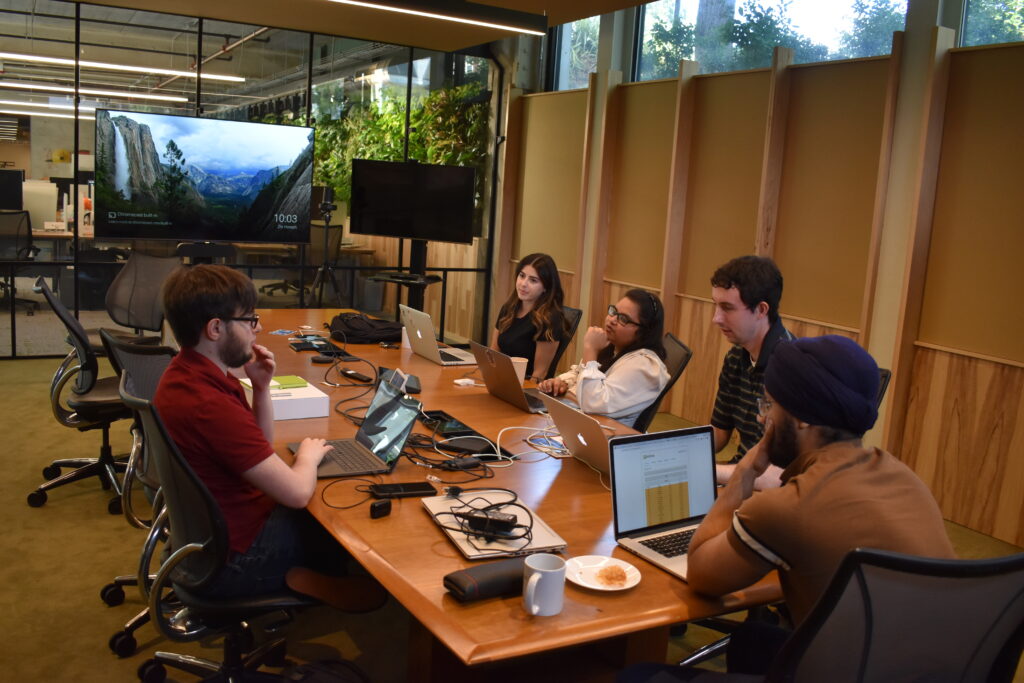By Paul Flamburis
Everybody loves games, which is why word games are such a valuable way to demonstrate NLP concepts. At Hackathon 2022, Team 3 decided to create their own Rosette -powered guess-the-word game based on semantic similarity.

From left to right: Ethan Roseman, Fiona Hasanaj, Chini Sinha, Ian Redpath, Harjas Sarna
The current word game craze was started by Josh Wardle when he created Wordle in 2021. Even if you haven’t played it, you’ve still probably heard of this game, which gives you six chances to guess a new five-letter word each day. After each guess, the game provides feedback based on the letters used. That game reached the height of its popularity in February 2022, but also inspired a legion of imitators such as Lingle, Quordle, and even Lordle of the Rings, which is a variant of Wordle that only includes five-letter words and names from the main text of J. R. R. Tolkien’s The Lord of the Rings. Team 3 was most interested in a game called Semantle.
Semantle, created by David Turner, is a take on the Wordle formula that provides feedback based on the semantic similarity of the guess to the hidden word, rather than spelling. Semantic similarity is the likeness of meaning between words. For example, the word “dog” has higher semantic similarity to the word “cat” than it does to the word “table.” Automated semantic similarity measurement is made possible thanks to a recent natural language processing innovation called word embeddings. Word embeddings are numerical representations (called vectors) of words and their position in vector space. Long story short: the closer two word vectors are, the more similar in meaning the corresponding words.
Word embeddings help to quantify a conceptual problem, and without them, games like Semantle wouldn’t be able to tell you how close each of your guesses was to the hidden word of the day. It just so happens that Rosette has its own word embeddings which drive things like our semantic similarity endpoint. Since the word game craze is still so fresh in the cultural zeitgeist, Team 3 had the idea to recreate Semantle using Rosette’s internal word embeddings. The game would then serve as an interactive demonstration of those word embeddings.
Even with Semantle as a design template, making a game is no simple task, and what makes this project even more impressive is the fact that the team consisted almost entirely of back-end engineers. In two and a half days, the team not only had to build a functional game, but learn to make user interfaces with React on the fly, making this a front-end underdog story for the ages. By all appearances, however, nobody on the team let the stress get to them. The members of Team 3 recall having excellent delegation of responsibility, easy communication, and a whole lot of fun.
Team 3 dubbed their game RVECle, short for Rosette Vector with the “-le” suffix characteristic of the Wordle-clone genre. (That’s not a knock, either, as anyone who remembers first-person games being called Doom-clones can tell you.) Team 3’s post-Hackathon presentation included an interactive segment with a reveal that wowed the audience: RVECle was already playable both on computers and mobile devices. It’s one thing to hear about how successful a Hackathon project was, but it was another thing entirely to be able to play it firsthand. The clean and responsive UI was proof that all of Team 3’s front-end learning paid off, and by the end of the day people were already wondering when the next day’s word would drop. It’s no wonder, then, that Team 3 walked away from the Hackathon with the Audience Choice Award.
One feature that separates RVECle from Semantle is that RVECle is multilingual. While there are versions of Semantle in other languages, RVECle includes English, Hebrew, Japanese, and more. The team wasn’t content to rest in Semantle’s shadow for long, however; they already have ideas for a suite of new and unique game modes that could separate them from the pack. “Tip of my Tongue” would ask the player to guess a hidden word given four other words with high semantic similarity. “Antonymle” would require you to guess a hidden word and its most semantically dissimilar word. In “Semiddlele,” the goal is to guess a hidden word that is semantically equidistant from two provided words. These game ideas, aside from sounding fun, are all fresh approaches to demonstrating the concept of semantic distance. With any luck, the members of Team 3 will return to the world of word game development and make them reality.



